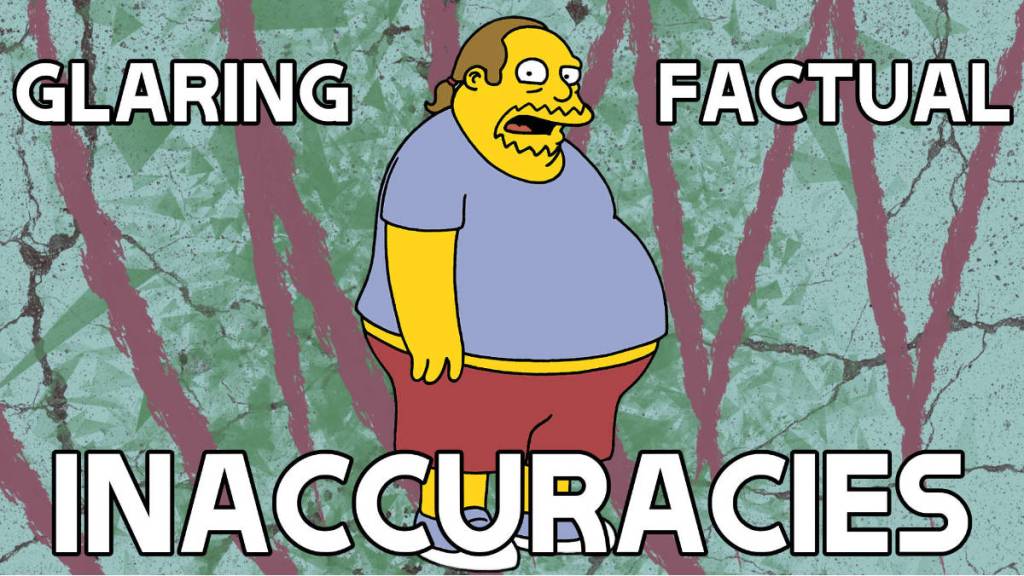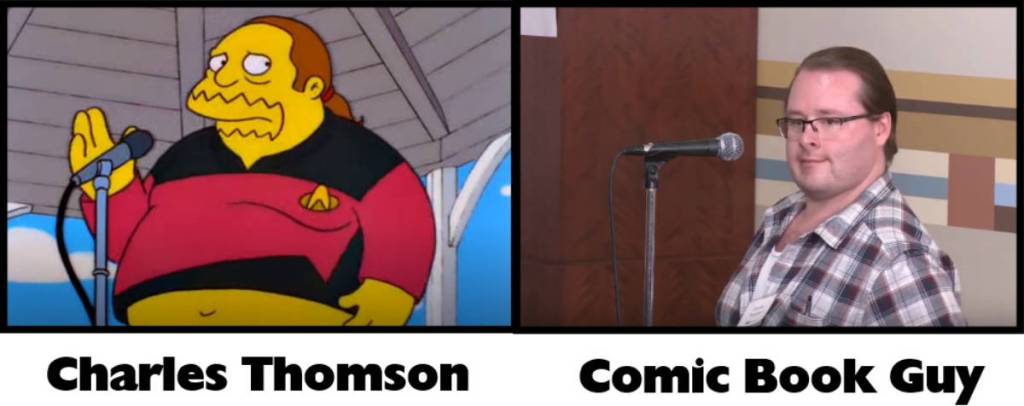
I’ll be honest, I’m not that familiar with Charles Thomson (@CEThomson). Sure, I’ve heard his name many times, and there’s no doubt he’s a Michael Jackson truther, and all-round obsessive fan.
The 30+ something year old “journalist” is popular within the I support unrelated man/boy sleepover community, and if you doubt Jackson’s innocence on social media or forums, there’s no doubt you’ll eventually be spammed with one of his videos, or articles.
Do a quick search on YouTube, and you’ll come across tons of Charles Thomson videos, the most recent ones, unsurprisingly, criticising Dan Reed’s Leaving Neverland, and its subjects Wade Robson and James Safechuck. In fact, Charles Thompson is so brazen in his support for Michael Jackson that his moral compass saw nothing wrong with giving an interview with John Ziegler, a 911 conspiracy theorist and open sympathiser of convicted child molester, Jerry Sandusky. Hmm?
One sticking point within the documentary, and something that’s been fully weaponised by Jackson truthers is the main Neverland train station and James’s timeframe of abuse between 88 and 92. This train station hadn’t received planning permission until September 1993, and despite unintentional claims by Jackson’s former photographer, Harrison Funk, that Jackson built it without a permit, initially, it probably (though not conclusively) didn’t exist in any substantial form until the latter part of 1993.
Just like Mike Smallcombe, who uncovered the planning permit, Charles Thomson himself displays chronic misconceptions and ignorance around the complexity of child sex abuse, and inconsistencies in timeframes and locations made by genuine survivors.
In a ever so brief 1:08m YouTube video, titled: “Truth Be Told Panel Charles Thomson” published on 6 June 2019, he drops a number of clangers, and proves that he a self-proclaimed Jackson “expert” couldn’t even get the simplest of facts from a 4 hour documentary correct.
In the video he states:
"What do you do when somebody makes an allegation and the other side is not responding or not able to respond? So, there are 2 things you do. The first thing you do is investigate, and Leaving Neverland did not investigate, because there are massive glaring factual inaccuracies in that documentary, it's full of them. You got a kid saying he was molested in 88 or 89, in a building that was not built until 1995."
Charles is then told that time is running out, but goes on to say:
"I'm not going to list everything, but it's teeming with errors, massive errors. So then what do you do? If you have not investigated you go to the other side for balance. They didn't do that either. And the filmmaker [Dan Reed] gave a ridiculous excuse that I included Michael Jackson's denials when he was alive, except he never denied these allegations because these guys never accused him until he was dead. You have lawyers who have been litigating with these guys for 5 years."
The video then ends abruptly.

Charles Thomson, perhaps high on his own narcissism appears to be the one who’s making making massive glaring factual inaccuracies, rather than Dan Reed or James Safechuck.
First and foremost, James Safechuck, in the 4 hour documentary makes no mention of when he was abused in the train station. His exact words are:
"At the train station, there's a room upstairs, and we would have sex up there, too. It would happen every day. It sounds sick, but it's kind of like when you're first dating somebody, right, and you do a lot of it."
James is also describing other Neverland locations within that sentence, for the record.
Secondly, the train station was already substantial in size by the end of 1993, and fully completed by the summer of 1994, at least according to Mike Smallcombe.
You can read my full analyst of the train station here.
Thirdly, Leaving Neverland isn’t limited to just allegations against Jackson. It documents how Jackson chose and befriended James and Wade and their families, how he became an integral part of their lives, before eventually losing interest and moving onto new and younger boys. These are facts that can be backed up with court documents, photographs and video footage.
Dan Reed has always stated that Leaving Neverland is about James and Wade, how they met Jackson, how Jackson groomed and seduced them into sexual contact and why they defended their abuser both publicly and under oath for so long. It’s not a case of he did no research whatsoever, he did, in fact, start off the entire process by interviewing former detectives and those involved in investigating Jackson in the 93 and 2005 case.
If any of the Jackson’s or former lawyers were invited to offer their opinion in the documentary, it would be the same scripted and limited response that Jackson was a wonderful man, all his accusers are motivated by money, blah, blah, blah, blah.
Anyway, let’s refocus and move back onto Charles Thomson and his glaring factual inaccuracies. This is a “journalist” who thinks that James Safechuck, a man who states he was abused over a four-year period over 25 years ago, in a place bigger than most housing estates containing a minimum of 50 to 100 different buildings and structures couldn’t somehow misidentify a site of abuse, or misremember his end of abuse timeframe by 1 to 2 years.
Well, guess what, Charles, you somehow screwed up big time, and couldn’t even get your facts straight from a 4 hour documentary that was aired in March 2019. You, along with Mike Smallcombe call yourselves “journalist”, yet you appear to be the only two who have never heard of inconsistencies in timeframes and locations made by genuine sex abuse survivors.
This is what Kenneth V. Lanning Former Supervisory Special Agent Federal Bureau of Investigation (FBI) has to say on the matter of inconsistencies when it involved multiple sexual acts over an extended period, Mr Charles Thomson:
"Allegations involving multiple acts, on multiple occasions, over an extended period of time must be evaluated in their totality and context. Cases involving longterm sexual contact with child victims who engaged in compliant behavior should not be assessed and evaluated by comparisons to cases involving isolated, forced sexual assaults. Indicators suggesting a false allegation in a typical rape case have little application to the evaluation of most acquaintance, child-molestation cases, especially those involving repeated access and prolonged sexual activity. Such child molestation cases are very hard to classify as either a valid or false allegation. Victim claims may include allegations that appear to be false, but that does not mean the case can be labeled in totality as “a false allegation.” In my experience, many valid claims of child sexual molestation, especially those by this type of child victim, involve delayed disclosures, inconsistencies, varying accounts, exaggerations, and lies often associated with false allegations. Inconsistencies in allegations are significant but can sometimes be explained by factors other than that the allegation is false. What is consistent and logical in these circumstances must be based on experience and knowledge of cases similar to the case being evaluated. Any indicators of a potential false claim must be applicable to the type of case in question and not based on cases involving one-time, violent sexual assaults. There is a difference between an unsubstantiated/unproven allegation and a false allegation. There may be many reasons to believe the allegations are not accurate and should not sustain a conviction in court beyond a reasonable doubt, but that does not mean the allegations of sexual victimization can be labeled as totally “false.” Labeling an allegation as false should mean nothing of a criminal/sexual nature occurred between the child victim and the alleged adult offender at any time."
Here’s a more simplified version why sexual assault survivors forget details, Mr Charles Thomson: bbc.com
Conclusion
The most hypocritical thing about Charles Thomson is that he isn’t exactly a journalistic novice when it comes to historical child sex abuse. He, along with his colleagues at Yellow Advertiser, a free weekly Essex-based newspaper obtained financial records released under the Freedom of Information Act which revealed ten compensation payouts by Essex Council for “alleged abuse” in the 1970s and 1990s. He even states on his own website that “his investigation has inspired multiple victims to report their abuse for the first time and has led to at least one arrest.”
Charles, however, displays chronic misconceptions about child sex abuse, or at the very least freely chooses to when it comes to Michael Jackson’s accusers. That is on full display in the above video and he doesn’t just try and twist the words of James Safechuck, or leave out important facts about inconsistencies, but strongly implies both men are financially motivated to lie by litigating with lawyers, even though as a “journalist” he was directly involved in publishing stories about cover-ups and compensation to genuine sexual abuse survivors.
Welcome to the world of Jacko’s Wackos.
